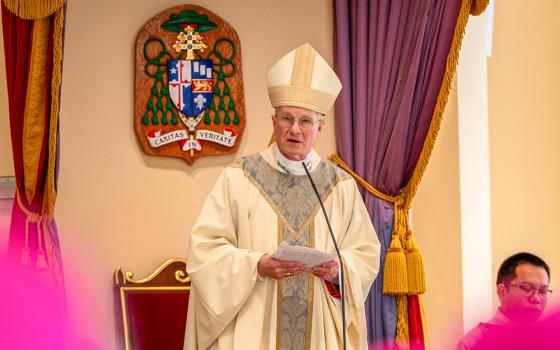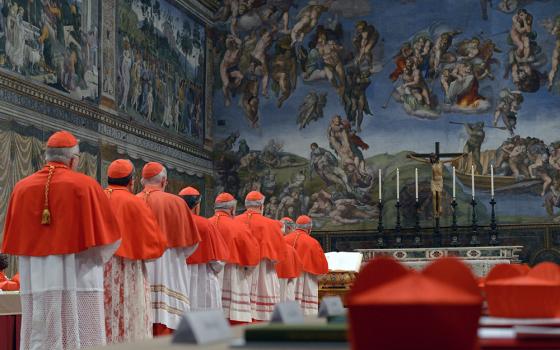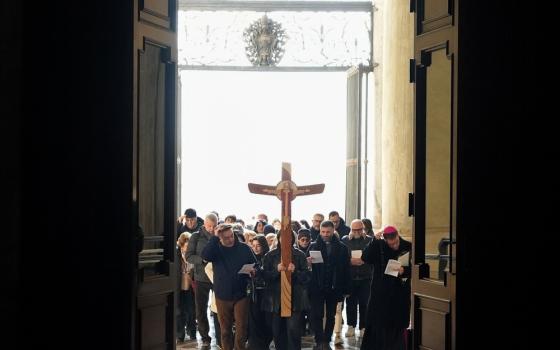
Always a deeply Catholic place, the South Bronx has long been associated with poverty, arson and crime. That's slowly beginning to change, thanks in part to immigrants and Catholic faith leaders. (Wikimedia Commons/Jim.henderson)
On the surface, it wouldn't seem as though Nestorio Agirembabazi has much in common with my grandfather. Apostles of Jesus Fr. Agirembabazi has served as a priest and pastor at New York City's St. Angela Merici Parish for two decades, after growing up in the Ugandan village of Bushenyi and attending college in Massachusetts and California.
My grandfather Leo, on the other hand, was one of 10 siblings in a family who came to the U.S. in 1907 from County Roscommon, Ireland, after a short stay near Liverpool, England. And yet both men ended up on the same hilly patch of asphalt and dirt: the South Bronx.
"The Irish and the Germans built this church with their meager resources," Agirembabazi told me during a recent visit to the parish rectory, nestled in the shadows of Yankee Stadium and the Bronx County Hall of Justice. "There's no way you can build a community here today without understanding that history. And we can still build on that history."
The past is very much on Agirembabazi's mind these days.
In September, St. Angela Merici marked its 125th anniversary, culminating in a Mass attended by hundreds of past and present parishioners, dozens of New York-area priests and New York Cardinal Timothy Dolan. Fordham University dean and celebrated constitutional scholar John Feerick, born into the parish in 1936, helped organize the anniversary celebration.
Asked why he stays involved in his old parish, Feerick said: "What I still find in the Bronx is an opportunity to express my Catholic faith in a God who asks us to help those in need."
'The Catholic church and its priests and parishioners, and others among the faithful and lapsed, did more than any other single group to lift the Bronx from ruin.'
—Ian Frazier
For decades, the South Bronx has been associated with poverty, arson and crime. That's slowly beginning to change, thanks in part to immigrants and Catholic faith leaders.
In August, the New York Times noted that the borough's "southern neighborhoods have been transformed ... by the march of new construction and high-rise rentals." Meanwhile, The New Yorker journalist Ian Frazier went so far as to title his new book Paradise Bronx: The Life and Times of New York's Greatest Borough.
"It's had a bad reputation for a long time. That was unfair," Frazier told me during a long chat in Joyce Kilmer Park on Walton Avenue. As we talked, ambulance sirens blended with the tinkling bell of an ice cream vendor and shouts from a nearby wedding party taking photos.
"I had the same impression of the Bronx everyone did for a long time. I didn't really know what was going on up here," added Frazier, an Ohio native who came to New York in the 1970s after graduating from Harvard.
"To come here and see immigrants just working so hard ... that's the glory of the U.S. It can still attract all of these people from all over the world," said Frazier, whose book sends a special shoutout to borough religious leaders.
"The Catholic church and its priests and parishioners, and others among the faithful and lapsed, did more than any other single group to lift the Bronx from ruin."

The New Yorker journalist Ian Frazier titled his new book Paradise Bronx: The Life and Times of New York's Greatest Borough. (Tom Deignan)
In the South Bronx, immigration is a bridge from the past to the present.
The St. Angela anniversary, and my conversations on faith and immigration, comes at a tense time. Border security was one of the most explosive issues in the 2024 presidential campaign. The rapid influx of asylum seekers has posed challenges even for liberal-minded New Yorkers. Religious activists and charity workers have become ensnared in immigration-aid controversies from Texas to New Jersey.
The Diocese of Paterson, New Jersey, sued several federal agencies amid fears that changes in U.S. immigration policies could impact thousands of foreign-born priests and the parishioners they serve.
Amid all that, the NYPD reported 32 South Bronx shootings in the first eight months of 2024, up from 20 last year.

Apostles of Jesus Fr. Nestorio Agirembabazi has served as a priest and pastor at New York City's St. Angela Merici Parish for two decades. (Tom Deignan)
Agirembabazi, now 64, admits that he didn't know what to expect when he arrived in the Bronx in 2000, after the New York Archdiocese requested support from his Apostles of Jesus order.
"It was a challenge in the beginning," Agirembabazi said, adding that the parish is now largely made up of Hispanics from all over the world, though mainly from Central America. "That's what makes it unique," he adds. "Despite the [challenges], it's still vibrant. ... People come from their home countries with their values and traditions and devotions, and share them. It's a blessing."
The original St. Angela's was "a small wooden building on the site of the present church," according to the writing of Class of '56 grammar school grad Graceann McKeon in a parish history. McKeon added that Fr. Thomas Wallace, along with two Ursuline nuns, were charged with setting up the operation. (St. Angela was chosen for the name because she founded the Order of St. Ursula in her native Italy.) The South Bronx was spacious and quiet back then, so immigrants saw it as a step up, especially once more infrastructure was built.
"The subways watered the Bronx, and an urbanized suburb sprang up," Frazier writes. By 1923, a baseball team originally known as the Highlanders built a new stadium on 161st Street. Star player Babe Ruth — who, like fellow star Lou Gehrig, spoke German at home to his parents — donated funds to the parish.
None of this seemed to ease growing fears about "aliens" and "demographic change" in 1920s America. Though it passed largely unnoticed, this year marked the 100th anniversary of the Johnson-Reed Act, which essentially ended mass immigration, reflecting grave fears that contrast sharply with Ellis Island nostalgia.
Then came the Great Depression, and with it a newfound collective desperation.
One September evening in 1937, Fr. Cornelius Hance happened upon a thief stealing $28 from the St. Angela rectory. In quintessentially Bronx style, "the priest delivered a blow to the chin," The New York Times reported. The perpetrator fled, but was apprehended shortly afterward.
Advertisement
By the 1950s, the brutal legacies of slavery and Jim Crow had sent millions of African American Southerners to the Bronx and other northern cities. Racism, industrial decline and misguided urban planning conspired to create harsh conditions in the area.
"The subways built the Bronx and the highways almost destroyed it," Frazier said.
Yet even through the "Bronx in burning" 1970s and high-crime 1980s, the seeds of a new vitality were planted. "The Bronx invented an art form (hip hop) that went around the world. And they did it while the place was burning down," Frazier points out. Notably, the neighborhood's global export of hip hop celebrated its 50th anniversary last year, stronger than ever.
Another of its most famous cultural contributions — break dancing — debuted as a competition at the Paris summer Olympics for the first time this past summer.
For St. Angela, now in its 126th year, Agirembabazi says that a top priority is continuing to increase lay participation in parish initiatives.
"Immigration is a strength for us," he adds. "They're coming here to work and participate. Are they a threat? No. They have something to contribute. They are not here to beg."
Despite their own financial challenges, parishioners have recently sent generous donations to Haiti, where international organizations say one in five families are living on the verge of famine; one more echo from the past that Irish Americans should hear very clearly.






